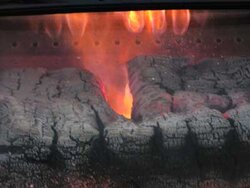.......16 or more years ago a few months after I purchased it soley to extend the burn cycle.
OK, I considered the ramifications of voided warranty , insurance, and never gave safety a thought either and to be honest I never had any regrets. I have always felt that EPA requirements at least partially forced the industry priority to satisfy test requirements . Anything else was a bonus.
The problem I had with the original configuration/design of the removeable baffle (secondary air plenum) directly above the fire was that it shot long flames out of the downward facing holes resulting in prematurely burning the top of the fresh re-load of wood , significantly decreasing the length of burn and producing more heat than necessary. I also think this same situation/reason might have contributed to complaints that the air supply control could not be lowered enough and led to some user modifications of that air control .
Ok , what I did was to bolt on a length of 1/4" X 1-1/2" flat stock with approx 3/8 " space between it and the row of downward facing holes (front to back) which effected/diverted the secondary air to enter the firebox from both sides of the flat stock vs straight downward. It worked like a charm and still does to this day.
The secondary burn above the fire is still colorful but the wood no longer burns from the top down prematurely.
Comments welcome.


